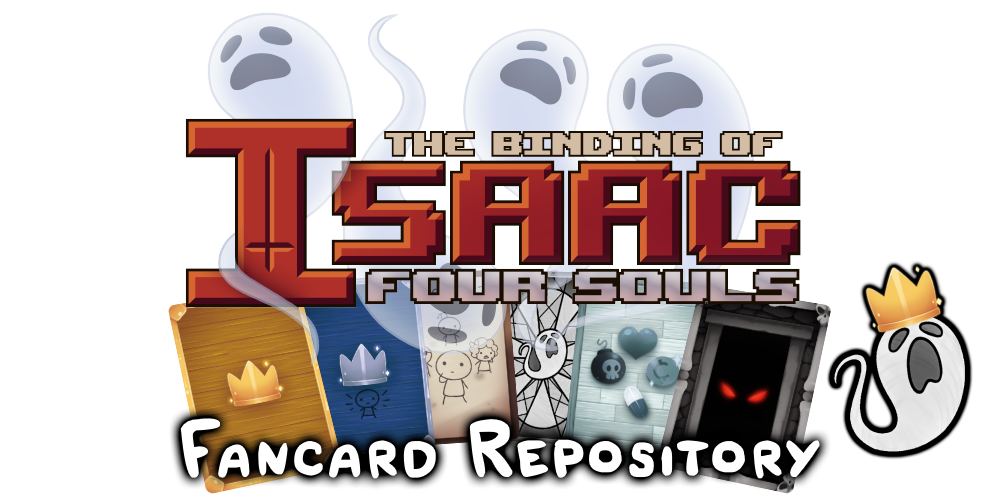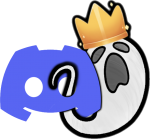Turn Structure Next
Dice Rolls
The Stack
Playing Effects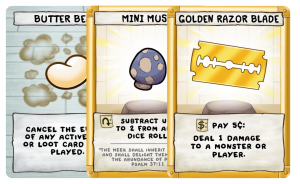
Each player has a number of tools at their disposal to steer the game in their favor including loot cards, activated effects, and paid effects. Doing any of those things is referred to as playing an effect. Additionally, on a player’s turn, they can purchase items, or attack monsters. Purchasing and attacking work differently than playing effects and are covered in their own sections.
During the game, players will regularly interrupt other player’s turns to play their own effects. Two systems determine what will affect the game next and which player can make the next move. These are the stack and priority respectively, and both will be covered in this section.
Stacking effects is where advanced strategy really shines, so make sure you read your loot cards and item effects carefully!
The Stack
The Stack is an important concept that determines the order of effects and also allows players to react to any effects that are played. The stack is the place where effects wait to resolve (affect the game). When something is added to the stack, it is always added to the top. The stack operates with a basic principle of last in, first out. That is to say that effects in the stack will resolve in the reverse of the order they were added to it: the last effect added to the stack resolves first, followed by the second to last, and so on until each effect on the stack is resolved.
It can be helpful to think of the stack as an actual physical pile of cards. As effects are played or triggered, you pile the cards on top of each other. When effects start resolving and leaving the stack, to find out what happens next, you take off the top card of the stack and do what it says. Each time you take something off, players have a chance to put more cards on. This continues until the pile is empty and nobody wants to play any more cards.
You choose the effect itself (for effects that say “choose 1”) and any targets for effects as they go on the stack. The following game events also use the stack and some involve multiple steps:
- Rolling a dice (see Dice Rolls)
- Purchasing (see Purchasing)
- Attacking (see Attacking)
- Combat damage (see Attacking)
- Monster death (see Monster Death)
- Refilling slots and decks (see Refilling Slots)
- Encountering non-monster cards (see Attacking/Refilling Slots)
- Player death (see Player Death)
Example Stack
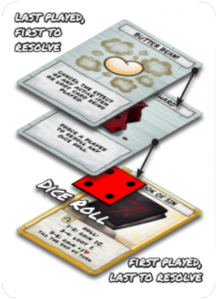 To the left is a visualization of a stack. Butter Bean and Dice Shard (loot cards) are played directly onto the stack, while the other two are representations of the dice roll result and Book of Sin’s effect.
To the left is a visualization of a stack. Butter Bean and Dice Shard (loot cards) are played directly onto the stack, while the other two are representations of the dice roll result and Book of Sin’s effect.
-
- Book of Sin was activated first, putting its effect on the stack.
- As Book of Sin started to resolve, it needed a dice roll. A roll was made and put on the stack.
- Dice shard was played in response to the dice roll targeting the roll.
- Butter Bean was played in response to the Dice Shard targeting the Dice Shard. As it stands it will resolve first, canceling the effect of the Dice Shard and preventing the roll of 4 from being rerolled.
The stack may seem complicated at first, but it is actually fairly intuitive and should become much clearer when you start playing the game. There are also some further examples of the stack in action available if you want them (see Further Examples).
Priority
Generally, at any given point someone has priority. The player with priority is the only player that can play effects. While a player has priority, they can either play an effect and keep priority, or pass priority to the next player.
Whenever a player adds an effect to the stack, they get priority. Whenever an effect is added to the stack by a triggered effect (see below), or an effect on the stack resolves, it is the active player who gets priority. In both cases priority will then pass round the other players in turn order, with each player deciding whether to respond and add to the stack, or to pass priority to the next player. When all players pass priority in succession, whatever is on top of the stack will resolve.
There are times when nobody has priority as certain things don’t use the stack. Players can’t play effects during these times.
Responding
Players can play loot cards or use activated or paid effects in response to whatever is currently on the stack. Doing so puts the response on top of the stack which will cause it to resolve before whatever is below it. Players can respond again as each effect in the stack resolves, building the stack back up. The active player can also respond while the stack is empty. In fact, this is the only time a player can purchase or attack (see Purchasing/Attacking).
Triggered Effects and Timing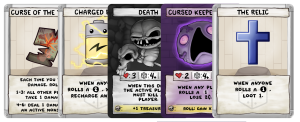
Triggered effects can be triggered by a wide variety of game events. When a triggered effect is triggered, its effect is added to the stack. If multiple effects trigger at the same time, they are put onto the stack in the following order:
- Effects from monster cards go on first, including monster death. If there are more than one, the active player chooses the relative order.
- All other effects go on the stack in turn order starting with the active player. If a player owns multiple effects, they choose their relative order. For the purposes of timing, a player ‘owns’ their death.
If the timing is not outlined here, the active player chooses the order of the effects in question.
Related FAQs
Loot Cards
Can I Butter Bean a trinket or the Lost Soul loot card?
Yes. Butter Bean can cancel any loot card being played, and trinkets aren't considered items till the loot card effect resolves. The same goes for the lost soul: it only becomes a soul card once the effect of the loot card resolves.
If a loot card is cancelled by a Butter Bean, in what order do the two cards go onto the discard pile?
The cancelled loot card would go on the discard pile first followed by the Butter Bean on top.
The Stack
If I use a card that has more than one effect on it to choose from and someone responds to it, can I choose a different option when my effect resolves?
No, you choose an effect when you put it on the stack, and once you've chosen an effect that effect is locked into place and can't be changed.
Can I respond to an item or loot card that deactivates my item by activating it?
Yes. The activation of the item would be above the item or loot card that would deactivate it on the stack, and therefore would resolve first.
Can I respond to something forcing me to discard a loot card by activating my player card and playing that card first?
Yes. The activation of your character card would be above the effect forcing you to discard a loot card on the stack, and therefore would resolve first. The same is true for effects where a loot card would be stolen rather than discarded.
Can I respond to a dice roll that would have killed me by using an item or loot card that simply kills the monster I’m attacking?
Yes, if a monster is killed during an attack via an outside source all attack rolls against that monster are cancelled as the attack ends when the monster is killed (and is therefore no longer in play).
What happens if two passive items trigger at the same time?
If two passive items go off at the same time their effects are added to the stack in player turn order, then resolve backward just like all other stacking effects. If one player controls multiple passive items that trigger at once, they choose the order the effects trigger and are added to the stack.
If I decide to attack the top card of the monster deck or buy the top card of the treasure deck and someone responds by rearranging or otherwise altering the top card(s) of that deck, can I take back my attack on/purchase from the deck?
No. Once a player has declared what they are attacking or purchasing they must attack/purchase that way when the declaration resolves regardless of what other players may do before then.
What happens if I’m attacking a monster that has a triggered effect on a specific roll and I also have an item that triggers on that same roll?
Monster effects are added to the stack first, followed by any other triggered effects. The effects will then resolve in reverse order like normal.
Can I respond to a dice roll that would have killed me by using an item or loot card that cancels my attack to avoid dying?
Yes. The item or loot card effect would be put on the stack above the dice roll and would therefore resolve first, cancelling the attack before the dice roll would resolve and kill the player.
Ask a question
Would you like a rule clarified? Do you think you've found an edge case? Have you checked on all relative pages to ensure the question hasn't been answered already?
If so, feel free to submit a question to our Card Tzar! He may decide to edit the article to clarify the issue, or to add an FAQ to clarify your question.
Turn Structure Next
Dice Rolls
